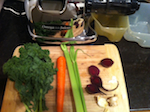Juicing has got to be a vegans best friend but the problem is that most juice contains a lot of sugar! In fact, I am quickly finding out that vegan cooking is quite high in grains and starches which are also forms of readily digestible sugars. The key to my success in this vegan experiment will in part be to eliminate all animal products but also to limit the consumption of excessive amounts of simple carbohydrates and fruit sugars. A bit of a challenge!
One way I have been getting a lot more veggies into my diet is through juicing. A client asked me, the other day, to post something about juicing and how to do it right … so here goes nothin’.
The first thing to know about juicing is that vegetable and fruit juices are highly susceptible to oxidation, or damage from light, heat and air, and should ideally be consumed within 15 minutes of being made for optimal nutrient freshness. This is the major problem with industrial juice … it is often made months before it reaches a store shelf and has to be pasteurized to prevent transmission of infection. Essentially the juice is dead!
Ideally juice is made from a masticating juicer! Although centrifugal, or juicers that spin around really fast, are the most common form of juicers and still better than nothing, the speed of the blades that are extracting the juice have actually been found to damage the nutrients. If you can imagine the process at the cellular level, the shearing force of the blades actually burns some of the compounds that are released from the cells … AKA the juice. This results in juice that has already been damaged before you get a chance to have it!
The degree of damage that occurs to the juice actually depends a lot on the speed that the blades are traveling. If people have a speed control on their juicer, it is optimal to have the blades spinning as slowly as possible, ideally below 3000 or 4000 revolutions per minute.
The final thing about juicing is that most people don’t like pure non-starchy vegetable juice, but non-starchy vegetable juice is the healthiest! I’m kind of a “get’er done” kind of guy, plus I have an iron stomach, so I could pretty much throw anything through the juicer and knock it back. Other people are a little more sensitive, so here are some tips to try if you are just starting out.
Pick one leafy green, my favorite of course is kale, and one local fruit or starchy vegetable, like an apple or carrot. This will make a really nice tasting juice and the kale components, which are the most nutritious but also the most bitter, will be off set by the sweetness of the local fruit or starchy vegetables. To get more fancy, each time you want to add a new local fruit or starchy vegetable, try and match it with a non-starchy vegetable …. like celery! Here is our food chart to help make your juicing decisions.
Juicing can also be a treatment for many different health concerns. Here are some juicing tips based on different health conditions!
Kale (and other cruciferous vegetables) is the best for treating and preventing cancers, but also very good for your eyes. A great juice for eye health and breast cancer treatment and prevention is kale carrot juice!
Gastritis, or irritation of the stomach lining, can be very quickly treated with cabbage juice. The gastritis juice I prescribe in the office consists of 2 parts cabbage to 1 part carrot, potato, and green bean.
Additions to juice can also be helpful depending on your goals;
- Add in garlic, for antimicrobial, detoxification, cholesterol lowering effects. Careful though … it’s hard on the gut!
- Add in cayenne to increase your metabolism or treat peptic ulcers and heartburn. Be prepared for your stomach symptoms to worsen though before they get better!
- Add ginger for immune function, nausea, and painful menstruation! This addition has also got some bite!
- Try adding cilantro for heavy metal detoxification!
